Leading through Values at the Vermeer Corporation
From its origins as a one-person shop on a central Iowa farm to its current status as a multinational global operation, the Vermeer Corporation has grown in every sense: number of employees, production locations and dealerships, the industries that it serves, and its product portfolio. But through it all it has maintained a focus on its guiding principles – putting people first, building the best, and giving back.
More than 70 members of the Manufacturing Leadership Council saw those principles in action when they toured the “Vermeer Mile,” Vermeer’s 3,500-employee corporate headquarters and primary production facility in Pella, Iowa.
 Vermeer traces its roots to a mechanical wagon hoist invented by its founder, Gary Vermeer, in 1948. The hoist could be used to raise the wagon from the front end to dump its contents, such as grain, out of the back. Now on its third generation of family ownership, the company continues to manufacturer products for the agricultural industry, including hay balers, bale processors and wrappers, feed wagons, and mowers. But they also service the utilities industry with such products as pipeline directional drills and trenchers, and the recycling and forestry industry with products like wood grinders and other equipment to process organic waste.
Vermeer traces its roots to a mechanical wagon hoist invented by its founder, Gary Vermeer, in 1948. The hoist could be used to raise the wagon from the front end to dump its contents, such as grain, out of the back. Now on its third generation of family ownership, the company continues to manufacturer products for the agricultural industry, including hay balers, bale processors and wrappers, feed wagons, and mowers. But they also service the utilities industry with such products as pipeline directional drills and trenchers, and the recycling and forestry industry with products like wood grinders and other equipment to process organic waste.
Vermeer defines itself as a low-volume, high-option manufacturer – they produce roughly 22,000 units annually with many customizations. Plant tour attendees were taken through their Plant 7 building – where precision welding and painting take place – and The Center, an under-construction facility set to open in January 2024 that will bring under one roof the company’s operations technical training, team member solutions, and an employee clinic and pharmacy.
Within its operations, Vermeer has a strong dedication to utilizing Lean principles and is now in its 25th year of Kaizen, having completed 3,082 Kaizen events as of September 2023. They have maintained a strong focus on the basics of Lean, including regular report outs, in what they deem as a relentless pursuit of waste elimination. The company’s practices in Lean and continuous improvement feed into its innovation for new products and processes.
In terms of what drives capital and technology investment decisions, the focus is on those that provide the best ROI in addition to labor savings and safety. Generally, projects that deliver ROI in less than 3 years will get scaled. They are also focused on building supply chain resilience, taking a proactive approach to ESG compliance, and flowing information between disparate systems. Additionally, the company is working through an MES implementation and bringing software onto the plant floor for more data-driven decisions.
Some of the technology that Vermeer has deployed includes smart tools that are connected to operator instructions. This includes digital welding instruction software that can help new welders to learn and experienced welders to improve quality. The company has also installed 11 robotic welding cells between its facilities in Pella and Des Moines, helping to reduce unfilled welding jobs while also boosting quality and productivity.
The company has also implemented a limited amount of automation, such as an autonomous material handling system for purchased parts that handles more than 60 daily deliveries to seven assembly lines. Here, company leaders discussed the lessons they have learned while implementing automation: first, there was a need to train maintenance teams for servicing robots, while also training engineering teams on designing for automation. They also advised to bring in an integrator to advise on best practices and to avoid preventable errors.
Vermeer also puts a high premium on ensuring its team members are set up for success. Every new production employee is given one week of Operations training, regardless of past work experience, to build their competence and confidence for working in a manufacturing environment before transitioning to the next step of technical training or to the production floor. This training includes welding, painting, assembly, safety, and machine shop skills. Additionally, they are given instruction on soft skills and professionalism under the acronym of DOTS – Dependable, Open-Minded, Team Player, Safe.
One of Vermeer’s most popular employee benefits is its on-site pharmacy, run in a partnership with Walgreen’s, that provides both prescription and over-the-counter medication and other pharmacy goods at cost. The company also provides a medical clinic open to employees and their families, as well as retirees. The clinic provides family care and can offer referral to specialists if needed and gives employees an opportunity to be proactive about their health. The company said this has helped them to save on insurance costs.
Another popular employee service is the Vermeer Chaplaincy program, a counseling service that is open to all regardless of any spiritual background or belief. The chaplains can provide a listening ear for issues that occur at work or at home and provide suggestions on possible avenues of support. The program was started in 2007 and has provided more than 4,200 individual support sessions in the last year alone.
Finally, the company also offers an on-site childcare facility, known as the Yellow Iron Academy, providing care for children from infants to school age. It is located on the site of the Vermeer family farm and provides children with education to prepare them for or augment their academic careers.
With a history of pride in innovation and building the best products, plus prioritizing team member success, Vermeer stands as a role model for operating a high-performing global manufacturing business while keeping a focus on value-driven leadership.
Dotson Iron Castings’ Story of Survival and Advancement
When a company traces its history back nearly 150 years, its story is likely one of continuous change and evolution. For Dotson Iron Castings of Mankato, Minn., it is also a story of survival, innovation and respect for people.
During the Manufacturing Leadership Council’s recent plant tour, Dotson’s leaders shared elements of this story and gave visitors a firsthand look at its production practices and culture.
Overcoming Obstacles
 With its roots dating back to a blacksmith shop founded in 1876, Dotson Iron Castings has persevered through early product failures, a 1937 bankruptcy, the 1980s recession, a 2017 fire, and the COVID-19 pandemic, and emerged stronger due in part to the company’s leadership, people and culture.
With its roots dating back to a blacksmith shop founded in 1876, Dotson Iron Castings has persevered through early product failures, a 1937 bankruptcy, the 1980s recession, a 2017 fire, and the COVID-19 pandemic, and emerged stronger due in part to the company’s leadership, people and culture.
In its early history, the company offered diversified products including an automobile, a tractor and its best-seller, the Little Giant Trip Hammer. The company also dealt in brass, aluminum, and steel. Since 1983, the 125,000 square foot foundry has focused solely on ductile iron primarily for the industrial, agriculture, and truck industry segments. By focusing on this single product, Dotson has become an iron casting and Manufacturing 4.0 leader.
Innovating for the Future
As the company has evolved, its leadership and employees have created a culture that respects people and encourages innovation. The company’s Manufacturing 4.0 journey has seen Dotson implement data generation and collection systems including a FARO Quantum Scan Arm that takes 3D measurements to inspect product quality. Other innovations showcased during the MLC tour include machine monitoring data, automated charging in the melt process and automatic mold pouring.

On the sustainability front, the company continues to find new ways to reuse energy and materials. It takes a tremendous amount of energy to reach iron’s 2700 degrees Fahrenheit (1482° C) melting point, which in turn creates heat energy that Dotson captures and uses to heat its facility in winter months, including an in-ground heating system to keep its loading dock area free from ice and snow – both common for Minnesota. The company reuses excess iron that is removed from castings in the finishing process and also reclaims the sand used in its molds, eliminating almost 70% of the non-recyclable waste leaving its facility.
Recognizing an Iron-Willed Team
 When an electrical contractor caused a fire that destroyed all the company’s molding lines in 2017, it took Dotson six weeks to rebuild its operation. Rather than send workers home, company leaders kept its frontline workers employed in the cleanup process or by sending them out into Mankato to complete community service work.
When an electrical contractor caused a fire that destroyed all the company’s molding lines in 2017, it took Dotson six weeks to rebuild its operation. Rather than send workers home, company leaders kept its frontline workers employed in the cleanup process or by sending them out into Mankato to complete community service work.
After rebuilding and reopening the foundry, the company’s then-owners, Denny Dotson and Jean Bye, envisioned and built a new worker-focused space with showers, changing areas, lockers, upgraded break areas including an outdoor terrace, and a more welcoming reception area. The company calls this new space the “Club House,” and it serves as a further indication of the company’s commitment to its people.
More than Just a Tour
For MLC’s plant tour participants, the visit to Dotson Iron Castings included more than just a tour of the foundry and Club House. Visitors had the opportunity to network with fellow Manufacturing 4.0 professionals, participate in one of three breakout sessions, and ask questions both during the tour and a capstone panel discussion.
 The breakout sessions dove deep into key topics facing both Dotson and participants alike: IT/OT Convergence, Energy Efficiency in an Energy Intensive Industry, and The Employee Center and Next Generation Workforce Influence. Dotson’s leadership team shared its experiences and answered questions, shedding light on the company’s continuing evolution.
The breakout sessions dove deep into key topics facing both Dotson and participants alike: IT/OT Convergence, Energy Efficiency in an Energy Intensive Industry, and The Employee Center and Next Generation Workforce Influence. Dotson’s leadership team shared its experiences and answered questions, shedding light on the company’s continuing evolution.
The event culminated with a wide-ranging panel discussion featuring nine representatives of the host company. The panelists fielded audience questions about workforce turnover, technology innovation, and how the company has perpetually overcome challenges.
The Dotson Iron Castings tour showcased how the company – forged in fire – has equipped its employees with the right technologies and created a culture that is poised to build on its 147-year history.
All photos courtesy Dotson Iron Castings
At Hershey, a Sweet History and Saltier Future Powered by Digital
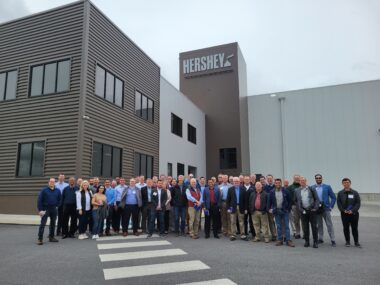
From its namesake chocolate bars to the immensely popular Reese’s Cups, The Hershey Company has been a maker of beloved confections for many decades. But no matter which variety is your personal favorite, Hershey’s powerhouse combination of manufacturing, fulfillment and distribution keeps those famous brands coming to store shelves and to the consumers who love them, generation after generation.
Nearly 100 Manufacturing Leadership Council members took part in a tour encompassing two Hershey facilities: the West Hershey plant in Hershey, Pa., and their nearby Annville Fulfillment Center in Annville, Pa., which is also Hershey’s first fully digital facility.
As a $10 billion publicly traded company, Hershey is perhaps most famous for its chocolate brands and other confections, but it also has expansion goals to evolve into a leading snacking powerhouse. To that end, it has acquired several brands of salty snacks, including Skinny Pop Popcorn, Pirate’s Booty puffs and straws, and Dot’s Pretzels. Its nearly 4,000 SKU brand portfolio is carried out through 21 plants (14 in the United States, seven internationally), roughly 950 global ingredient and packaging suppliers, 60 contract manufacturing and contract packaging partners, 34 distribution centers, and 143 freight carriers.
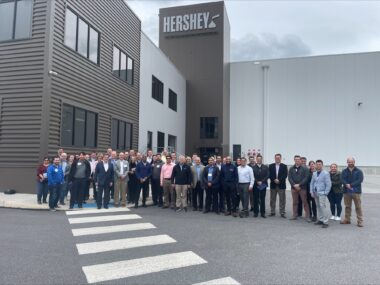
One thing that leadership emphasized on the tour was Hershey’s move from “best in cost” to “best in class.” Fulfilling Hershey’s vision as a snacking powerhouse means focusing on people-first manufacturing, which includes skill development, career advancement and teambuilding; innovating through technology, including through its digital factory strategy; and a focus on reliability. But in addition to its future aspirations, Hershey also needed to respond to evolving market and operational conditions – the company saw more volume growth during the pandemic, but retirements meant that its mean labor tenure decreased significantly, while lead times for packaging and capital equipment lengthened. Those shifts means that the company was left with a need to respond faster.
Investment in transformation capabilities has been essential. The company has moved away from conventional lines with single-purpose assets and focused SKU portfolios with complex line changeover requirements to advanced technology lines that can handle diverse SKUs with faster cleaning and changeover capabilities. Overall, Hershey’s digital factory strategy is focused on four areas: data capture and analysis to facilitate rapid problem identification and resolution; physical automation; a digital backbone (encompassing universal data architecture), and digital quality to bring forth a paperless shop floor. The company performs mass customization at scale through robotics and digital integration.
During the visit to the West Hershey production plant, which originally opened in 1990, attendees got an inside look at some of the production lines in the world’s largest and most technologically advanced chocolate manufacturing plant (750,000 square feet). It takes 26,000 cows to supply the milk needed to produce the Hershey’s Kisses (70 million a day), chocolate bars and syrup made here – one million pounds each of milk chocolate and Hershey’s Syrup each day. There is no storage for intermediaries at this facility – as soon as products are made, they are put onto a truck.
The 800,000-square feet Annville Fulfillment Center started production in October 2021, going from its groundbreaking to operation in just 16 months. It includes 62 trucking bays and 18 packing cells with flexibility to handle packages anywhere between two ounces and six pounds. Some of its advanced features include a cloud-based technology stack, digital work instructions for operators, and environmentally friendly battery-powered forklifts. The company will continue to scale up operations there as they leverage the facility’s full capacity.
The Annville facility is a joint operation between Hershey and its logistics partner, DHL. While Hershey owns the facility and its capital equipment, the majority of the workforce there are DHL employees. The Annville leadership team says that the partnership capitalizes on the strengths of both organizations, such as Hershey’s digital production know-how and DHL’s warehousing and logistics expertise. The facility utilizes a flex labor setup with cross-training between machine operators, palletizing operators and other functions to ensure that operations are adequately staffed at all times.
During the tour’s panel discussion at the end of the day, leadership emphasized that one important aspect of Hershey’s success is the company culture, originated by founder Milton Hershey more than 100 years ago. Bringing the workforce on board has allowed them to accelerate past “pilot purgatory” for the company’s digital aspirations. Panelists described what they call “Hershey nice” – a mix of collaboration and consensus-building where everyone treats each other with respect. The culture is vested in the company’s success, which therefore means that there is passion to share success and continually strive for improvements.
For that reason and many more, the company behind “the sweetest place on earth” might also be one of the sweetest places to work, and why Hershey is positioned to grow successfully toward its future aspirations – starting on the factory floor and branching out to snack lovers everywhere.
Witnessing World Class Manufacturing at Whirlpool Corporation
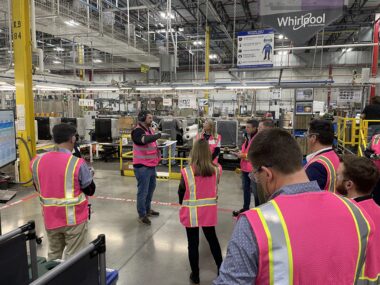
When Whirlpool Corp.’s Findlay Operations began its World Class Manufacturing (WCM) journey in 2018, the effort was envisioned as a standardized way to drive out waste and loss while keeping their customers in mind.
In March, the Whirlpool team welcomed guests for the Manufacturing Leadership Council’s sold-out tour of the company’s Findlay, Ohio, factory, where visitors learned about the WCM methodology, witnessed the facility in action, and heard directly from company leaders. The visit included information about automation efforts, sustainability programs, training programs, data collection and use, maintenance procedures, and kaizen and other continuous improvement processes.
The nearly 2,200 employees at the Findlay facility manufacture thousands of dishwashers each day including stainless steel and plastic tub varieties. The factory first opened in 1967 and has seen several additions, growing its footprint to one million square feet today. It is one of five Whirlpool manufacturing centers in Ohio and among 56 manufacturing and technology centers worldwide. In 2022, Whirlpool recorded $19.7 billion in net sales.
About World Class Manufacturing: Whirlpool Corp.’s Findlay Operations transitioned from a system based on the Toyota Production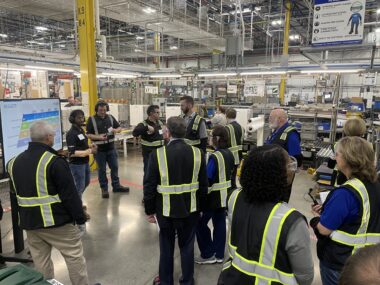 System to WCM in 2018. WCM features 10 Technical Pillars that are built on top of 10 Managerial Pillars. Both are essential to achieve WCM status. WCM’s primary goal is to increase quality while reducing production costs. The operating model focuses on driving out waste and loss by demonstrating successful pilot processes that are then spread broadly via standardization.
System to WCM in 2018. WCM features 10 Technical Pillars that are built on top of 10 Managerial Pillars. Both are essential to achieve WCM status. WCM’s primary goal is to increase quality while reducing production costs. The operating model focuses on driving out waste and loss by demonstrating successful pilot processes that are then spread broadly via standardization.
The WCM audit system has revealed significant progress at Whirlpool, Findlay Operations. Two times per year, the plant is audited by external parties to assess their progress against the WCM methodology. As pillars progress and meet specific criteria, they are awarded points. In the fall of 2022, the Findlay plant scored 53 points during their WCM audit. A score of 50 or more results in being awarded the Bronze-level award for WCM. The next milestone is at 60 points which is a Silver-level award. This scoring is standard for those using the WCM methodology.
What They Saw: For the nearly 100 MLC attendees, the highlight was seeing Whirlpool Corp.’s operation in action.
To make their way around the bustling factory, attendees were broken into seven tour groups, each named after a Whirlpool brand: Maytag, KitchenAid, Amana, JennAir, Swash, Gladiator, and the flagship brand Whirlpool.
During the seven-stop journey, tour leaders shared concrete examples of how standard work is put into practice and how continuous improvement, Kaizen activities and the Plan-Do-Check-Act (PDCA) cycle affect processes and help the company balance safety, quality, and costs. In fact, at the Workplace Organization stop, participants learned how the plant’s Kaizens have saved the plant millions of dollars since 2019.
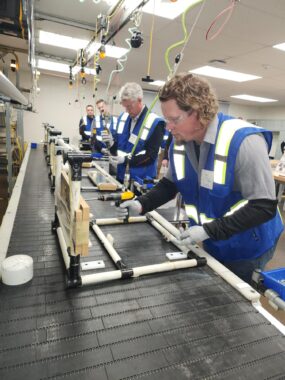 Along the route, participants saw Automated Guided Vehicles (AGVs) deliver supplies to workstations and heard from tour leaders and frontline leaders. At one stop, guests learned how flipping the dish rack when installing rack clips had saved time, avoided awkward hand and head angles, and decreased worker frustration. Elsewhere, a new lever – 3D printed on site – allowed workers to reduce the force necessary to install the dishwashers’ sump pumps, resulting in a five-year period without a reportable incident and two years without any first aid incidents.
Along the route, participants saw Automated Guided Vehicles (AGVs) deliver supplies to workstations and heard from tour leaders and frontline leaders. At one stop, guests learned how flipping the dish rack when installing rack clips had saved time, avoided awkward hand and head angles, and decreased worker frustration. Elsewhere, a new lever – 3D printed on site – allowed workers to reduce the force necessary to install the dishwashers’ sump pumps, resulting in a five-year period without a reportable incident and two years without any first aid incidents.
At yet another tour stop visitors saw an automated cell completing a foam-in-place process featuring a robot that has run millions of cycles to date. The company uses automation like this to avoid the 3Ds: tasks that are dull, dirty, or dangerous. Automation allows the company to avoid these 3Ds while providing safer and more interesting work to take place.
Off the factory floor, tour stops included a visit to the Compass Room where data on every machine and process is analyzed so the company can ensure safety and quality while reducing waste. The room provides a place for company leaders to look at the full picture, tie waste back to its root cause, and figure out priorities to address the top losses. From there, the groups also stopped for an overview of the company’s sustainability efforts, which include a pledge to achieve net zero by 2030 with the help of two on-premises wind turbines.
Finally, tour groups visited the Manufacturing Training Area (MTA) where the company demonstrated the training process that employees go through to learn new skills or brush up on existing capabilities. Every new hire starts their Whirlpool experience in Findlay’s MTA. In this training area, staff assess employees and then assign them to stations on the factory floor where they can operate safely and efficiently while measuring up to Whirlpool’s quality standard. To avoid monotony and repetitive stress injuries, Whirlpool workers each have at least three jobs they can do in the factory. Each worker rotates his or her position on the line to undertake these approved job functions during each shift. In fact, some workers are certified in as many as nine frontline jobs.
Diving Deeper During Breakouts and An Expert Panel: The plant tour concluded with three breakout sessions followed by an open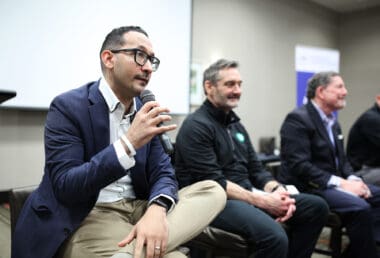 question and answer session with Whirlpool leaders. The breakouts allowed participants to learn more and ask questions about WCM, the Kaizen Management System, or MTA and People Development.
question and answer session with Whirlpool leaders. The breakouts allowed participants to learn more and ask questions about WCM, the Kaizen Management System, or MTA and People Development.
The tour contingent reconvened for an expert panel moderated by David R. Brousell, MLC’s co-founder and executive director. During a lively session, participants were able to pick the brains of some of Whirlpool’s brightest minds including Kristin Day, Findlay Operations Plant Leader; Ramsey Aljahmi, Operations Excellence Lead, NAR; Scot Blommel, Senior Manager, Global Sustainability; and Brent Schnipke, Ottawa Operations Plant Leader.
Award-Winning Leaders: There is no shortage of industry expertise and award-winning talent at Whirlpool’s Findlay plant. Kristin Day was recognized as a 2020 STEP Ahead Honoree by the Manufacturing Institute (MI), the nonprofit workforce development and education partner of the National Association of Manufacturers, MLC’s parent. Additionally, Industrial Engineering Manager, Tyra Woodruff, was honored with a STEP Ahead award in 2022, while Amy Doroff, Senior Manager, Material Control and Logistics, was honored as an MI Emerging Leader that same year. Now called the Women MAKE America Awards, the program recognizes women who have achieved success within their companies and proven to be leaders throughout the entire industry. MI’s Emerging Leaders are young women who have demonstrated exceptional accomplishments as they begin their careers.
MLC’s next plant tour will be at The Hershey Company on May 1-2. For more information about upcoming MLC plant tours: https://www.manufacturingleadershipcouncil.com/event/plant-tours/
Imagining an Industrial 5G Future at Ericsson
Members of the Manufacturing Leadership Council were given a glimpse of the future of factory connectivity at the Ericsson USA 5G Smart Factory in Lewisville, Texas and Imagine Studio Tour in Plano, Texas. Exploring the theme Effectively Managing 5G and IoT to Drive Smart Manufacturing, tour participants learned about a highly autonomous and sustainable operation that manufactures Ericsson’s portfolio of 5G products, including advanced antenna radios.
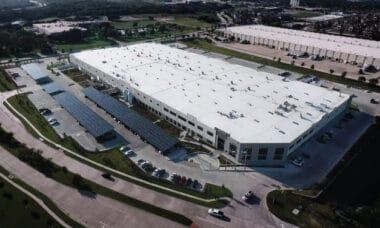
The Lewisville facility was recognized as both a Global Lighthouse and Sustainability Lighthouse by the World Economic Forum, just one of six factories worldwide to win both designations. The Smart Factory has more than 400 employees from 36 different countries.
5G is hailed for its promise in industrial settings due to its low latency and high reliability. It is considered critical infrastructure by the federal government, meaning it is considered so vital that it is designated for special protections and falls under national policy for maintaining its security, resiliency, and function. Additionally, an industrial 5G network requires fewer wires and fewer access points vs. advanced wifi networks. For example: In an 80,000-square foot area of the production facility, just two 5G radios are required for the network. The same connectivity on wifi would require 24 routers.
The plant utilizes automation, interconnected equipment, machine learning and real-time data enabled by IoT solutions and a private 5G network. Constructed in 2019, the facility was built in less than 180 days and delivered its first commercial 5G radio in July 2020. It produces a range of 5G radios for private networks and deployment by cellular carriers for their nationwide networks.
The surface mount assembly lines at the Ericsson USA factory are the longest in the United States at 271.6 feet. The factory layout can be described as a hub-and-spoke assembly system connected with automated mobile robots (AMRs). The equipment includes AMR docks, which allows the AMRs to move components through various stages of assembly. This allows operators to stay focused on production vs. tracking down necessary components.
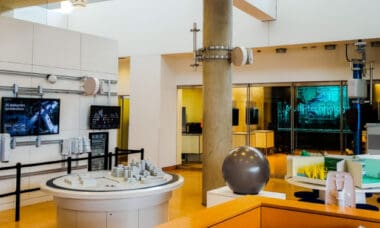
The manufacturing team at Ericsson says they are focused on “sensible automation” as not everything makes sense to fully automate – for example, final assembly is done with human operators working with collaborative robots. In other areas where it is practical, faster and more efficient industrial robots are deployed instead. The plant runs on a private network separate from Ericsson’s corporate network, and all of its network solutions are hosted on-premises.
On the sustainability front, Ericsson is reaching for an ambitious Net Zero goal in all of its operations by 2030, with a goal of being Net Zero in its entire value chain by 2040. The Ericsson USA factory is 24% more energy efficient vs. comparable buildings, using renewable energy through 1,646 solar panels that generate 17% of the energy required for the factory. All of the energy the facility uses is from either wind or solar sources. It also has two 40,000-gallon tanks for collecting rainwater, which is used for maintaining its drought-resistant, native species landscape and in the facility’s restrooms.
After touring the production facility, attendees were taken to Ericsson’s Imagine Studio where they were given a deep dive into the performance differences between 5G and other previous generation wireless networks, the considerations necessary when planning for 4G/5G connectivity needs, an overview of private cellular networks, and identifying top 4G/5G-enabled use cases for the factory. Topics of discussion included how to align business goals with network deployment, how to select partners and system integrators, understanding risks, and how advanced networks can be deployed on both new and legacy production lines.
As for its future goals, the Ericsson team says that while product variability is currently a challenge from an automation perspective, they aim to control production with AI and machine learning for even greater autonomous operations; 5G will be a crucial component to handling the variability. They describe the process of adjusting their highly automated operations as a journey that is about learning as a team with production, network engineering, and product development. They are also actively pursuing a production digital twin.
Ericsson’s M4.0 philosophy would be good for any manufacturer to emulate: Continuously try new things and evaluate them. Be willing to fail. Aggressively chase production efficiency. Envision the type of company culture that is necessary to be innovative and to meet business goals. And most of all, imagine what is possible and set that as the highest goal.
See the full lineup of MLC’s upcoming plant tours at https://www.manufacturingleadershipcouncil.com/event/plant-tours/.
Creating the Future Workforce at Lincoln Electric
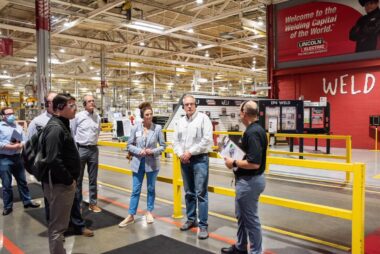
Lincoln Electric has a long and storied history since its 1895 founding in Cleveland, Ohio, as a manufacturer of electric motors. Today, it is a global industry leader in welding equipment and consumables, additive manufacturing, and automation solutions, and has expanded across 19 countries worldwide and serves customers in over 160. But how does Lincoln keep a connection with its origins through a continued spirit of innovation and learning?
Lincoln Electric first opened its welding school in 1917 and a century later launched its state-of-the-art Welding Technology & Training Center, in 2018. This 130,000-square foot facility includes training stations for virtual welding, where all students start their introduction to welding, and more than 150 training booths for learning on the real ‘arc’. There are classrooms to accommodate both live and online instruction.
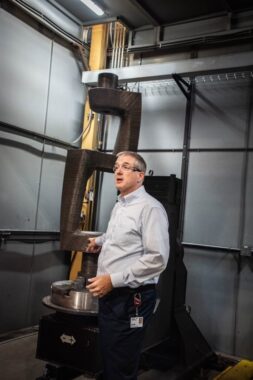
Lincoln Electric’s welding training is given to its new employees and external welding students. In addition, Lincoln also offers both turnkey and custom welding training curriculums and courses for customers to help them upskill their professional welders to achieve specific business targets and goals. They also offer a “train the trainer” course for welding instructors to ensure today’s students are getting the most up-to-date instruction to be industry-ready.
MLC members were given a first-hand look at Lincoln Electric’s headquarters in Cleveland at a recent plant tour that included visits to the welding training center in addition to the company’s machine division, where it builds welding equipment and consumables, as well as its large-scale additive business (3D printing) and their automation solutions.
Lincoln Electric is proud to have a high-performance culture that recognizes and rewards success and provides employees with opportunities for growth and development. The company’s Incentive Management System (IMS) for the production workforce includes piece work pay to maximize personal earnings potential, an annual profit-sharing bonus, a no-layoff policy, and an open-door policy including an employee-represented advisory board, who regularly meet with management to discuss various HR and operational matters. The IMS has been studied by the Harvard Business School and is one of the school’s top-selling case studies.
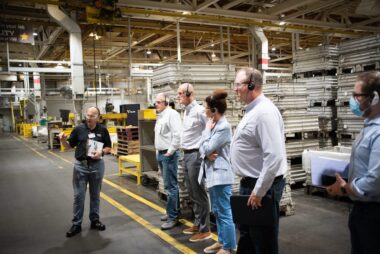
Lincoln Electric’s state-of-the-art, large-scale metal 3D printing solution is an extension of its automation, software development and metallurgical expertise, which has been applied to an additive process. The company’s additive solutions center is the largest platform of its kind globally with 18 3D printing cells which are used primarily to print replacement parts, molds, tooling and prototypes that measure up to eight feet in length and weigh more than 8,000 pounds – and are printed in a variety of metals including mild steel, stainless steel, nickel alloys, bronze, and Inconel. The solution serves a variety of industries including automotive, aerospace, marine, and energy. Customers provide Lincoln with CAD files or their parts and functional requirements and can expect finished parts in weeks versus months when using traditional castings or forging.
The tour stop in the Automation Solutions Center demonstrated Lincoln Electric’s portfolio of automation solutions that are aimed at increasing productivity and addressing the industry’s skills gap. The technology offered includes automated arc welding products, collaborative robots, metal fabrication, and assembly line solutions. The company has seen increased demand for its collaborative robot solutions in particular as manufacturers attempt to shore up their workforce shortages.
So what lies ahead as Lincoln Electric’s biggest challenge? Like most manufacturers, company leadership says that the core focus must be on people – to continue to build a pipeline of talent and attract, develop, and grow the next generation of leaders.
Additionally, Lincoln will focus on expanding its additive manufacturing and automation businesses in line with current trends and demand from customers in a variety of industries. But the company also intends to keep a focus on having a robust product portfolio that feeds into its bread and butter: a comprehensive and vertically integrated welding business, recognized around the world.
Experiencing M4.0 at The Smart Factory @ Wichita Tour
MLC members glimpse manufacturing today and tomorrow during The Smart Factory @ Wichita tour
When a factory tour begins with stops in the Today Room and Tomorrow Room, it’s clearly not a business-as-usual tour. That’s how many of the participants at the MLC’s latest factory tour started their experience when the capacity crowd visited The Smart Factory @ Wichita.
What they saw: Hosted by Deloitte and Infor, participants were shepherded through a tour of the showcase factory and visits with representatives from Amazon Web Services (AWS), Dragos, Infor, and Siemens. These sessions covered advanced manufacturing techniques, cybersecurity, cloud data analysis, Internet of Things, digital twins and more. Along the way, the tour group experienced a look at how Manufacturing 4.0 is shifting what is possible on a factory floor and in the control center.
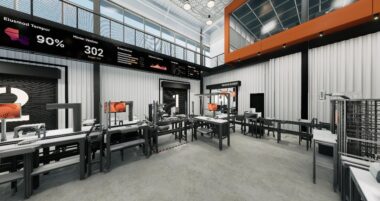
The factory tour began with a visit to the Today Room where participants heard about and saw the history of manufacturing. The tour then transitioned to the Tomorrow Room where, like something out of an amusement park, participants were invited to interact with a display table that showed advancements that are coming soon. From there, visitors moved into the heart of the tour where they saw M4.0 technology in action, and perhaps made a quick pitstop for a coffee brewed by the Smart Factory’s robotic barista.
The last stop on the tour was a visit to the control center where real-time data is synthesized and displayed related to The Smart Factory operation and Deloitte’s other immersive manufacturing experiences in Kyoto, Japan and Dusseldorf, Germany. The control center also served as an opportunity to showcase various systems within The Smart Factory’s ecosystem and how they work together.
A fully functional factory showcase: The Smart Factory @ Wichita is located on the Wichita State University Innovation Campus, and provides visitors with a completely immersive experience that brings smart manufacturing applications to life. Housed in a net-zero building, The Smart Factory is powered by a smart grid and manufactures science, technology, engineering and math (STEM) kits that are made of 100% recycled PET (RPET). The STEM kits, called Smart Rovers, are created in collaboration between Deloitte, Elenco Electronics and AWS, and will be donated to schools across the U.S. with the goal of inspiring the next generation of innovators.
M4.0 Discussion: The event concluded with a discussion featuring panelists Jason Bergstrom (Deloitte), Dave Kang (Dragos), Ken Hall (Siemens), Clint Schneider (AWS), and John Shorter (Infor). Moderated by Penelope Brown, the MLC’s senior content director, panelists discussed customer value, cutting through the noise, strategies for implementing and scaling M4.0, upgrading brownfield facilities, lights-out manufacturing, and the importance of communication, culture, data, and integration across the entire business.
As used in this document, “Deloitte” means Deloitte Consulting LLP, a subsidiary of Deloitte LLP. Please see www.deloitte.com/us/about for a detailed description of the legal structure of Deloitte LLP and its subsidiaries.
At IPG, A Relentless Focus on Business Value
MLC members tour IPG's plant in Utah and learn about the company's digital transformation journey.
For Intertape Polymer Group, a manufacturer of paper- and film-based packaging products, the last six years have been a time of significant growth – and change.
Revenue during that period doubled from $750 million to $1.5 billion at the end of 2021. With 10 companies brought into the fold through acquisition, as well as through greenfield plant expansion, IPG more than doubled its worldwide factory footprint. The company, with dual headquarters in Montreal, Canada, and Sarasota, Florida, now has operations in 34 locations, including 22 manufacturing facilities in North America, and approximately 4,000 employees.
But one of the most significant changes along the way, and one that will most certainly shape its future, is a digital transformation that began in 2018 that is now being rolled out in 10 of the facilities.
To see how IPG’s digital journey has played out in one of those facilities, approximately 70 members of the Manufacturing Leadership Council toured IPG’s Tremonton, Utah plant in April. Built in 1997, the plant makes shrink films such as StretchFLEX. MLC members saw how IPG uses data from plant floor equipment such as extruders to more rapidly identify and remediate problems; how it more effectively manages parts with an automated storage system called VIDIR; how it uses so-called “hackathons” and a digital-first mindset to problem-solve; and how it uses 3D printing to speed parts making.
In a briefing before the tour, Jai Sundararaman, IPG’s Vice President of Business Transformation, described why and how IPG undertook its digital transformation journey.
He said IPG was facing a set of issues as it contemplated its digital strategy – gains from lean manufacturing were plateauing, the workforce was ageing and retirements were underway, and the potential of new technologies was looming but not yet embraced. Moreover, digital was seen as a way to “homogenize” the company’s operating culture, an important requirement as a result of the acquisitions.
To prepare for the development of its digital transformation strategy, IPG undertook a series of explorations and activities, including studying 20 different technologies, attending more than 10 industry conferences, holding multiple technology summit with vendors, and engaging in more than 25 networking sessions with fellow MLC members, Sundararaman said.
The company then adopted a phased approach to digital transformation anchored on delivering business value.
Phase one of the digital transformation was designed to reinvent operational excellence for the digital era by, in particular, using its foundational Intertape Performance System (IPS) to closely align strategy and execution and “homogenize” the company’s operating culture.
“We have cracked the code in delivering bottom line results,” said Sundararaman, who is also a member of the MLC’s Board of Governors. “And we have uncovered three to five years of opportunities for driving sustained competitive advantage with operational excellence leveraging digital technologies and processes.
“So it was about raising the game to a higher level. I would characterize it as a ‘breaking the four-minute barrier’ moment. It was truly a watershed moment when the Tremonton team broke the yield numbers and sustained it for several months. Now, the records are starting to tumble down for other lines.”
Phase one also includes systematically up-skilling and retaining talent with digital and process knowledge. Phase two will be about driving revenue and margin growth by applying digital technologies at scale in other functions such as customer engagement, he said. And Phase three, which is probably a year away, will be about business model invention leveraging digital technologies.
One of the most significant changes had to do with how IPG thought about the process of problem-solving. Before its digital transformation, as it was explained during one of the tour stops, problem-solving was undertaken using a traditional sequence – hypothesis, questions, data, and answers.
The digital sequence, though, is different. It begins with big data, followed by exploration, correlations, and, finally, insights.
During an hour-long panel discussion following the tour, IPG plant officials answered questions from MLC members concerning data standards and analysis, measuring the return from M4.0, and how to get buy-in from employees and leadership teams for M4.0 initiatives, among others.
The panelists were also asked about the future possibility of achieving so-called light’s out status in a plant and the role of artificial intelligence in operations and continuous improvement.
“We have different camps with our own groups,” one panelist said. “However, we are very surprised at the tangible results we’ve seen in the initial stages of writing these algorithms and what’s possible with AI and how self-correction could become much more common.”
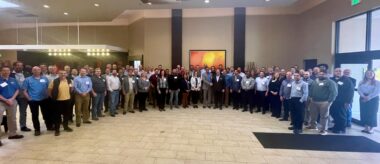
Inside BASF’s Customized Digital Training Simulators
Wherever your company is on its Smart Manufacturing journey, one stubborn issue remains: reducing human error. Whether it’s insufficient operating practices and procedural follow-through, equipment operation failures, or inconsistencies in shifts due to capability issues, the human component is a key feature of any reliability strategy for forward-thinking manufacturers.
In a virtual factory tour held September 8, MLC members got an inside look at how BASF Chemical Intermediates is implementing Voovio Technologies US Inc.’s Enhanced Reality training software simulation system to move both new hire and refresher training into the digital age.
BASF Chemical Intermediates, a division of German multinational chemical manufacturer BASF, manufactures approximately 600 products — including butanediol and its derivatives, amines, organic acids, polyalchohols, life science intermediates, solvents and OASE gas treatment solutions — which are sold to chemicals and plastics, agriculture, energy and resources, consumer goods, and nutrition and health customers around the globe. With six Verbund sites and 241 additional production sites in more than 90 countries, BASF’s products provide the building blocks for everything from shoes and clothing to construction, medicine, and fertilizers used in agriculture.
As it continues to move along its digitization journey, BASF is using data and digital technologies — including digital simulation training — to create additional value for its customers by increasing the efficiency and effectiveness of its manufacturing processes. BASF Chemical Intermediates partnered with Voovio to design customized digital training simulators to ensure its front-line operations and maintenance personnel are engaged, fully trained, and able to deploy the digital tools the company needs on its journal to increased operational excellence.
MLC members on the tour learned about the three main components of the Voovio simulation system: the digital Plant replica, digital procedure simulators where trainees can learn and practice procedures, and the field execution tool, which assists operators in the field as they execute the procedures they’ve learned.
The digital plant replica is built using real photographs — not animations — to create an immersive, realistic, interactive, and navigable environment that can be accessed by individuals on a computer, and shared virtually using standard video conferencing tools. Trainees can see everything in the environment and select components such as valves, pumps, and control panels to get a detailed view of each component, which are tagged and ID’d, and behave as they would in the physical environment to replicate the real functionality of the equipment. They can digitally “grab” and manipulate the components with a mouse or finger as they search for them, or from a searchable index. The simulators also offer enhanced views where the operator can overlay process flows and click on any piece involved in that workflow to see how it fits into the process. This unambiguous representation of the actual plan is useful for onboarding new operators and refreshing the knowledge of current workers.
The system also includes guided, learn, refresh and test modules that provide the replica, the procedure, and an action checklist so operators can focus on one action at a time in the procedure’s sequence. The guided module is like a virtual subject matter expert (SME) that enables technicians to learn and practice various procedures by doing them virtually. Once the operator has completed one step successfully, they get instant feedback. The system also includes knowledge snippets, which could be in any multimedia format, that include text, videos, job plans, plant drawings, and other bits of critical knowledge that may not be a formal part of the step but are accumulated bits of tribal wisdom new operations or maintenance technicians can access to learn from those who came before. The test module uses the same basic setup but provides immediate feedback to confirm whether the operator completed the step correctly. The system generates a test performance report and detailed activity log and also captures testing analytics for each trainee.
The field execution tool enables operators to take the training out of the computer screen and onto the shop floor. Using a tablet or approved digital device, employees can do a test run on the fly to ensure they know what to do before they do it.
BASF’s goal for implementing the simulation system was to update its operator training model to be faster, more interactive, self-directed, and be more systematic about capturing and transferring organizational knowledge from experienced operators to newer employees. The VOOVIO system is designed to reduce the time spent on-boarding with SMEs during traditional orientation, job shadowing, field demonstrations and written tests, while increasing competency, learning, and productivity.
In addition to reducing the time its SMEs spent training others by half and greatly accelerating the learning process, BASF has used the simulations to reduce unplanned events and startup delays, improve equipment reliability, reduce downtime, increase safety, and maximize profitability.
Nexteer’s Tracing System Drives Global Manufacturing Improvements
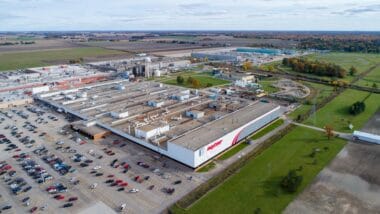 Nexteer Automotive is on a mission to make driving a car safer, more fuel-efficient, and future-focused through its production of steering and driveline safety-critical car and truck electronic and hydraulic power products. In addition to electric and hydraulic power steering systems, steering columns, and driveline systems, the company manufactures advanced driver assistance systems (ADAS) and automated driving-enabling technologies for more than 60 customers in every major region of the world, including BMW, Ford, GM, Toyota, and Volkswagen. Nexteer’s products complete the connection from the steering wheel to the wheels on the road.
Nexteer Automotive is on a mission to make driving a car safer, more fuel-efficient, and future-focused through its production of steering and driveline safety-critical car and truck electronic and hydraulic power products. In addition to electric and hydraulic power steering systems, steering columns, and driveline systems, the company manufactures advanced driver assistance systems (ADAS) and automated driving-enabling technologies for more than 60 customers in every major region of the world, including BMW, Ford, GM, Toyota, and Volkswagen. Nexteer’s products complete the connection from the steering wheel to the wheels on the road.
With software being a key component of most of Nexteer’s products, it’s no surprise that this multi-billion-dollar global business used a data-driven, holistic, and integrative approach to manage its complex global operations. Called the Digital Trace ManufacturingTM (DTM) System, it was created by Nexteer to provide a global architecture that connects and standardizes the thousands of data-producing components generated by its 27 manufacturing plants around the world.
In a virtual factory tour held on August 11, Manufacturing Leadership Council members got to see DTM in action. On the first stop on the tour, MLC members saw the production processes and traceability system at work at the company’s Plant 3 in its Saginaw, Mich., site, near the company’s headquarters in Auburn, Mich. The Saginaw facility, Nexteer’s largest, includes six manufacturing plants comprising 3.1 million square feet of manufacturing floor space where all the company’s core products are made. The site also houses a powerhouse and water treatment site, a global technical center, a test and validation center, and a test track. MLC members learned about the complexities involved in running a large-scale automotive component manufacturing plant, as well as how Nexteer has improved its manufacturing processes using the DTM system to connect data and maximize efficiency across the 150 operations required to manufacture its rack-and-pinion EPS products.
At the next stop, participants learned about how Nexteer uses data-acquisition tools to manage its business. Every time a new program is launched, a detailed process flow map is created for each step. This information is then shared with the equipment builders, so the machines are designed and programmed appropriately for the needed data processing, including what data will be sent to traceability and which processes use barcode scanners or other methods to track part serial numbers, such as RFID tags.
It’s one thing to have a large system collecting data — and it’s another to be able to use that data effectively. Nexteer uses intelligent manufacturing, big data, and local technology to collect, move, store, notify and summarize information for its global traceability system. The system, which is used in all the company’s plants to track information from thousands of machines daily, collects cycle time information. If there’s a fault, it collects and stores information including operation error codes and a description of all the pertinent information.
The data displays summary information for current station status directly on the floor on an hour-by-hour basis. It also makes historical information available for problem-solving purposes and provides automatically generated daily and weekly reports on all facets of the operation that are sent to cross-functional groups for awareness and problem-solving. Flawless materials control and delivery also is critical for production line efficiency, and Nexteer’s system can track material from receiving and shipping through the production line with single-box precision.
Not only does the system allow them to eliminate discrepancies by tracking the movement of each piece of material with high precision, it also eliminates the need for physical inventory processes. The ability to understand the manufacturing process outputs, and how these outputs affect your business goal, is extremely powerful. Nexteer uses its Center of Analysis (COFA) to communicate and correct any issues that arise.
Nexteer’s innovative approach to integrating design and manufacturing systems, from DTM to COFA, enables the company to deliver a dynamic, comprehensive view of its global manufacturing operations on a minute-by-minute basis — and benefits the company’s employees, customers, and shareholders.






